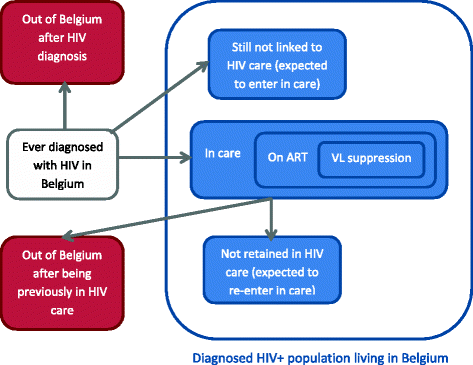Good continuum of HIV care in Belgium despite weaknesses in retention and linkage to care among migrants
- PMID: 26530500
- PMCID: PMC4631021
- DOI: 10.1186/s12879-015-1230-3
Good continuum of HIV care in Belgium despite weaknesses in retention and linkage to care among migrants
Abstract
Background: The Belgian HIV epidemic is largely concentrated among men who have sex with men and Sub-Saharan Africans. We studied the continuum of HIV care of those diagnosed with HIV living in Belgium and its associated factors.
Methods: Data on new HIV diagnoses 2007-2010 and HIV-infected patients in care in 2010-2011 were analysed. Proportions were estimated for each sequential stage of the continuum of HIV care and factors associated with attrition at each stage were studied.
Results: Of all HIV diagnosed patients living in Belgium in 2011, an estimated 98.2% were linked to HIV care, 90.8% were retained in care, 83.3% received antiretroviral therapy and 69.5% had an undetectable viral load (<50 copies/ml). After adjustment for sex, age at diagnosis, nationality and mode of transmission, we found lower entry into care in non-Belgians and after preoperative HIV diagnoses; lower retention in non-Belgians and injecting drug users; higher retention in men who have sex with men and among those on ART. Younger patients had lower antiretroviral therapy uptake and less viral suppression; those with longer time from diagnosis had higher ART uptake and more viral suppression; Sub-Saharan Africans on ART had slightly less viral suppression.
Conclusions: The continuum of HIV care in Belgium presents low attrition rates over all stages. The undiagnosed HIV-infected population, although not precisely estimated, but probably close to 20% based on available survey and surveillance results, could be the weakest stage of the continuum of HIV care. Its identification is a priority along with improving the HIV care continuum of migrants.
Figures



References
-
- Cambiano V, O’Connor J, Phillips AN, Rodger A, Lodwick R, Pharris A, et al. Antiretroviral therapy for prevention of HIV transmission: implications for Europe. Euro Surveill. 2013;18(48):20647. - PubMed
-
- Sasse A, Deblonde J, Van Beckhoven D. Epidémiologie du SIDA et de l’infection à VIH en Belgique: Situation au 31 décembre 2013. Brussels: Scientific Institute of Public Health; 2014.
Publication types
MeSH terms
Substances
LinkOut - more resources
Full Text Sources
Other Literature Sources
Medical

